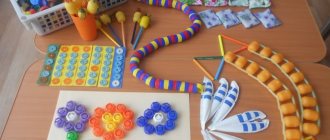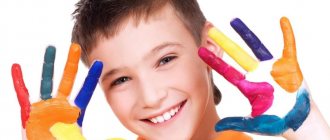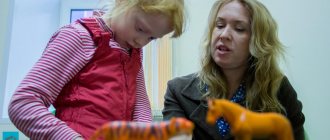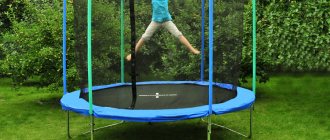THE IMPORTANCE OF FINE MOTOR SKILLS
Fine motor skills of the hands are a unity of coordinated manipulations that are aimed at performing small precise movements with the hands and fingers. Just a few decades ago, parents did not have problems with the motor skills of their children. After all, the children did a lot of things with their own hands: they helped peel vegetables, make pies, do laundry, sort out cereals, tie shoelaces and fasten buttons. Today, most of these activities are done either by adults, allowing children to play, or by specialized machines. Even Velcro shoes and clothes with zippers deprive the child of the opportunity to practice the fine movements of his fingers.
Meanwhile, a lot says about the importance of fine motor skills. Children with weak motor skills are not ready for writing and often lag behind in speech development. All this affects school performance and leads to increased stress on the child’s nervous system.
Among other things, the state of fine motor skills of the hands directly affects the development of the child:
- self-care skills;
- perseverance;
- thinking;
- attention;
- imagination;
- vocabulary;
- memory.
After all, the centers of the cerebral cortex responsible for fine motor skills are adjacent and closely interconnected with the centers responsible for the development of these areas. By activating the fine motor area, we naturally influence the neighboring ones.
Card file of exercises and games with goals according to the Federal State Educational Standard
The card file of exercises according to federal standards includes the following types of classes:
- to relax your arms (hands);
- for the development of motor skills using an unsharpened hex pencil;
- for the development of motor skills using natural materials (cones);
- for the development of motor skills with the help of a prickly massage ball.
The first type includes the following exercises:
- "Fish" in the water;
- “Helicopter”, which involves winding thread around an elastic band or ball;
- “Hedgehog” with palms;
- “Hare and Fox” with quickly and slowly “walking” fingers;
- “A conversation between two”, involving interaction between several group members;
- “Flight of the Birds” with active hand work;
- “Track” with buttons sewn to the fabric;
- “Pebbles” with plasticine laid out in a straight line;
- “Watch” aimed at active movements of the hands;
- “Lock”, which includes movements of the fingers and hands;
- “Spider” - moving fingers along the wall;
- “Scissors” with cutting movements of the fingers;
- “Firefighter”, which involves running your fingers along a “ladder”;
- “Peck fingers” - connecting the thumb with the rest in turn.
The second type includes the following exercises:
- “Pencil rolling” using the palm of your hand;
- “Making fire” with rolling a pencil up and down between your hands;
- "Slide" with rolling a pencil up and down one hand using the other hand;
- “Spinner” with a pencil spinning on the table;
- “Helicopter” with a pencil spinning in the air;
- “Crane” with lifting an object with two fingers;
- “Excavator” with lifting a pencil with your finger;
- “Swing” with swinging a pencil with two connected fingers.
The third type includes the following exercises:
- “Twist the bump” using your palms;
- “Roll the bump” using your palms on the table;
- “Catch the cone” by throwing it from hand to hand.
The fourth type includes the following exercises:
- rolling an object back and forth on the table;
- rolling an object around the table in a circle;
- finger pressure;
- catching a thrown ball;
- pressing on the ball with both hands;
- moving the ball from hand to hand with acceleration.
Doing exercises with children in English
Finger games and exercises
Finger exercises and games include many variations that require small and large objects of different types and densities. Paper, cereals, bulk and small items are suitable for this.
Important! It is best to accompany lessons with sayings in poetic form. Thanks to this, children will develop their speech apparatus and memory.
Many of the exercises will be useful to the baby in the future (for example, the ability to tie shoelaces, fasten buttons).
Finger drawings
Finger drawings as an element of classes are recommended to be done before lunch. During this period, children are especially active. At first, it is worth conducting a lesson for a couple of minutes, gradually increasing the time to 20 minutes without breaks.
For classes you need to purchase special paints, sold in any store. They have a special consistency that does not require adding water. The lid should fit tightly to the jar.
The sheets you choose should be A3 format so that the child can safely draw and the colors are bright. The presence of “CE” on the box means that the product meets world-class standards.
Massage of palms and fingers
Massage is a key point in the development of children's motor skills. The massage includes stroking the arms from fingers to palms, including the hands. Classes are accompanied by tongue twisters and poems.
Finger massage
Note! Before the massage, you need to warm up the baby's hands. The duration of the procedure should not be more than 5 minutes. Massage should be done for 10 days once a month.
EXAMPLES OF FINGER GAMES
So, the development of fine motor skills in children 3–4 years old begins with the simplest games:
- Actively rub your palms and ask your baby to do the same.
- Show your child how siblings greet each other - the fingers of the same name on your hands: touch each other alternately with your little fingers, ring fingers, middle fingers, index fingers and thumbs, telling your baby that this is how brothers greet each other. Let him try again.
- Let the baby imagine that his index and middle fingers are legs that are stomping along a path (for example, into the forest for sweet strawberries). His fingers should precisely walk along the surface of the table.
- And now let him turn into an old grandmother (grandfather) who cannot see well. The doctor prescribed glasses for them (the child uses his thumb and index fingers to pretend to be glasses, bringing them to his eyes).
A little later, when the baby gets used to such exercises, you can start playing with short rhymes, gradually adding longer rhymes and complex movements.
- boat
A hare is swimming in a boat (the child folds his hands in the shape of a boat),
The little bunny calls to swim with him (the baby waves his hands with inviting gestures).
- cat
How painfully does a baby cat bite?
He decided that he saw not a finger, but a mouse!
But I'm playing with you, baby,
And if you start biting, I’ll say: “Come on, shoot!”
When performing this game, the mother takes an old clothespin with a relaxed clamping mechanism so that it does not catch painfully, and “bites” each of the child’s fingers in turn.
- Curlers
The essence of this game is to bend each finger on the baby's hand in turn. To do this, you can use a variety of nursery rhymes. For example, these:
This finger is daddy.
This finger is mommy.
This one here is a grandpa.
This is grandma.
Well, this finger is me.
That's my whole family!
(You need to start counting with your thumb to finish with your little finger)
This brother found a fungus.
It began to cut him.
It was my brother who was frying a mushroom.
This one just ate and ate,
Look how fat he has become!
(Counting, on the contrary, starts with the little finger and ends with the thumb).
HAND DEVELOPMENT NORMS
After 3 years, children’s motor skills become more complex and varied: the percentage of actions that require coordinated hand movements from the child increases.
What should children of this age be able to do in terms of developing fine motor skills?
- To hold objects, they increasingly use their fingers, rather than the palm, as before.
- Able to hold a pen or pencil.
- They can draw lines, circles, polyhedra, redraw crosses and squares.
- They know how to cut paper shapes with scissors.
- Can take off and put on clothes and shoes.
- Grab small objects or parts with your thumb and index finger.
- Build a tower with at least 3 cubes.
- Draw a person consisting of at least 3 elements (head, torso, limbs).
- Take out small objects from a transparent container.
- Unscrew the lids.
- String beads onto wire.
- They can draw with their fingers.
- Scoop the cereal into a spoon from one container to transfer it to another.
- Trace the outline along the dotted line.
- Simple elements are molded from plasticine.
- Fasten and unfasten zippers, clasps, snaps, buttons.
- Sorting small items and cereals.
- Unwrap candy wrappers.
- They tie knots.
- Hand movements occur through coordination with vision.
All these skills need to be developed and improved, preparing little hands for increasingly complex and precise manipulations.
If your baby does not yet know how to do something from this list, it is important to fill this gap in a timely manner. Teach him age-appropriate skills, otherwise he will have problems later: he will have to not only learn new skills, but also catch up with his peers where he lags behind. And this is more difficult.
FINGERS PLAYING
However, the most interesting activity for children is finger games: all kinds of rhymes, tongue twisters, nursery rhymes, mini-performances that are performed only with the help of fingers. Here we present several new options for finger games.
But first, here are a few rules for conducting activities that develop fine motor skills:
- Work with your child regularly, include hand massage, games with small parts, creative activities, and finger exercises in your training program.
- Finger gymnastics should last from 5 to 15 minutes, no more, otherwise the baby will get tired and switch his attention to something else.
- Before starting the exercises, you need to warm up your palms by actively rubbing them against each other.
- Remember that now it is difficult for children to perform movements with both hands at once, so start with one, then repeat with the other, and only after that try to synchronize the hands.
- Keep in mind that the child may not remember all the movements or words of the game the first time, this is normal at their age. Everything will work out gradually.
- The baby will also learn to correlate words with movements during the lessons; if he doesn’t succeed right away, encourage him and help him perform the action.
- Move from simple to complex. If a child is offered an exercise that he cannot do, next time he will simply refuse to play.
- Try to interest your child by organizing games with his favorite characters, melodies, and rhymes.
- Do not exercise if your baby is unwell or in a bad mood. Don't force it. There are no useful games against the will of the player.
WHAT CONTRIBUTES TO HANDBOOK DEXTERITY?
There are many ways to make little fingers more skilled. The following games and activities perfectly develop fine motor skills in children aged 3–4 years:
- fastening buttons, snaps, lacing;
- unscrewing lids on jars and bottles;
- rolling pencils, nuts, spools in the palms;
- modeling from plasticine or dough;
- sorting of cereals (peas, beans, buckwheat, rice);
- finger painting on sand, semolina or buckwheat;
- drawing with finger paints or pencils;
- cutting out figures along the contours;
- games with small details (constructor, mosaic, puzzles);
- stringing large beads on fishing line or wire;
- feeling surfaces made of various materials and textures;
- massage with spiked balls.
When your child paints with finger paints, put on things that you don’t mind getting damaged by paints, and cover the table with protective oilcloth to make subsequent cleaning easier.
Most of these activities captivate children 3–4 years old, especially if parents give them the form of an entertaining game. For example, they suggest not just sorting out the cereals, but helping Cinderella go to the ball, not just touching different surfaces, but imagining yourself as a blind Mole from the fairy tale about Thumbelina, and guessing what you touched.








